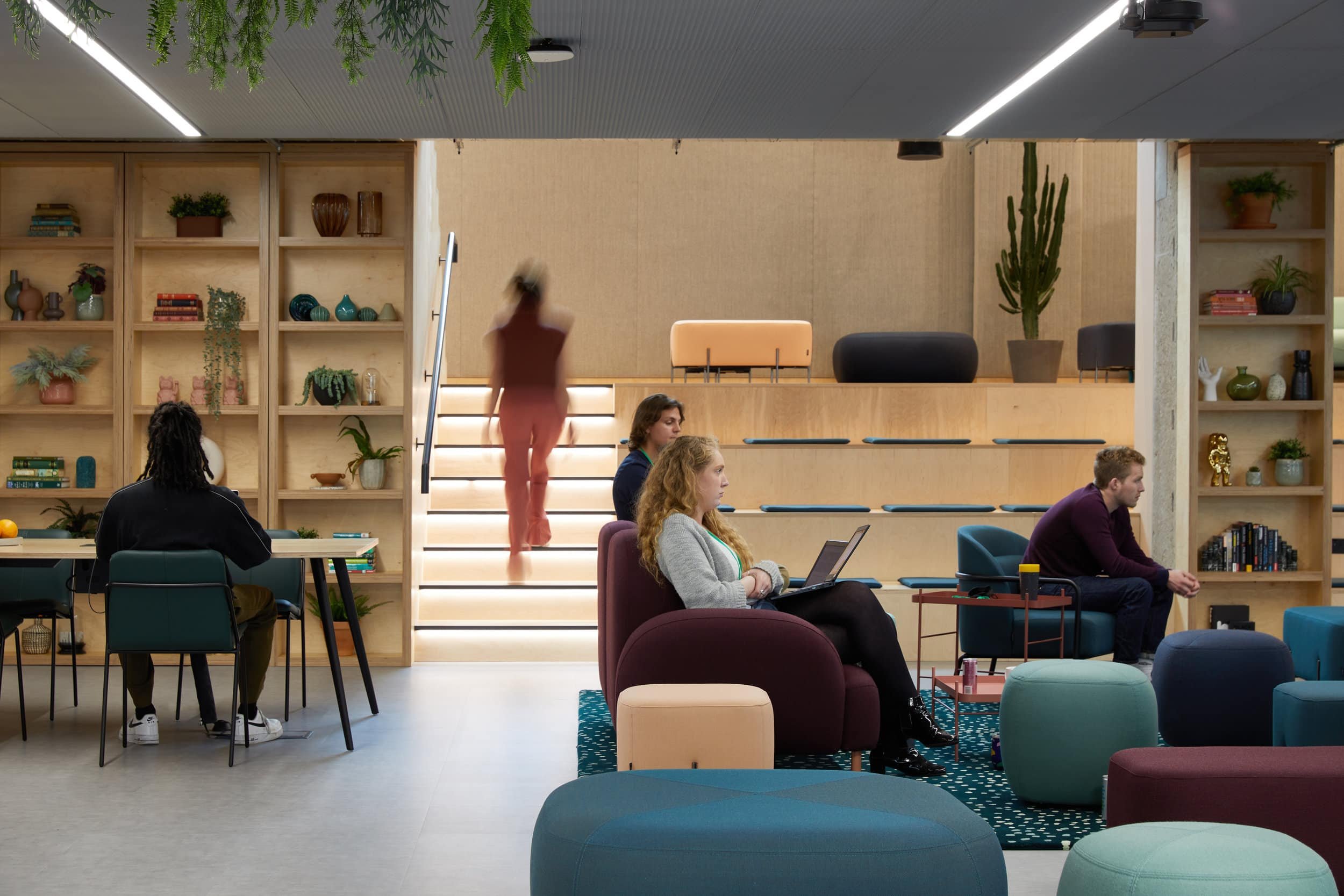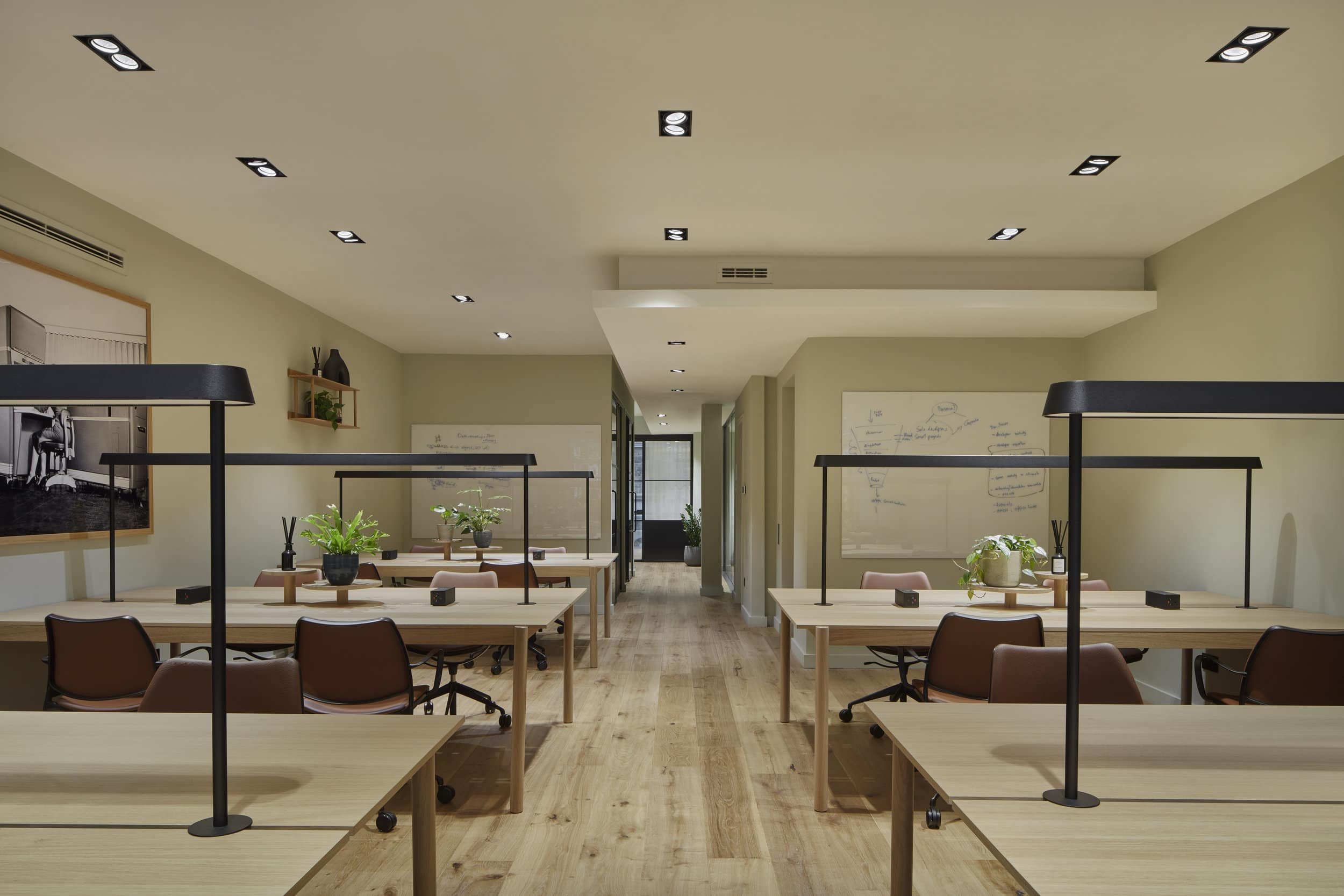How Can Office Design Support Productivity?
There are of course, many aspects beyond spatial design that will impact how productive we are at work; Having a good night's sleep, being well-rested, being hydrated (2-2.5 litres per day!), not being hungry/eating well (productivity can be reduced 25% with inadequate diet) and of course our mental wellbeing.
According to The WELL Building Institute, Workplace Design that considers air quality, lighting, nature views, and overall interior design and layout, can have a significant impact on staff health, satisfaction, well-being, and productivity.
Below are key factors that should be taken into account when setting up a supportive and efficient working environment.
Agile Working
Office workers require reasonable room to move around freely. Staying put at a desk for extended periods without breaks is counter-productive and impairs concentration. Ensuring workers have adequate space, encouraging them to move around through the day and providing alternate types of spaces to work from, is critical to any successful Office Design strategy.
Productivity
In a study of Productivity by UCL, Lead author Dr Kerstin Sailer (Bartlett School of Architecture, UCL) found that workers with more visual control over their office environment were up to 40 times more likely to report higher levels of productivity, focus, teamwork and team bonding
A coworking space at trili tech gives plenty of space and good lighting to employees and visitors
Office Design That Works
In the aforementioned UCL study, it was found that workers with higher numbers of desks in their field of vision were less likely to rate their workplace environment favourably, possibly due to distractions and difficulty talking to Co-Workers without disturbing others. Smaller open-plan offices with fewer desks also helps workers to feel more focused and productive, the researchers found. Workers at window desks felt more productive and focused than those sitting next to walls - windows providing both a view and sense of space, as well as natural light. Whilst is often impossible to give everyone a desk adjacent to window we can and should be considering sight lines and access to light during the office design process.
Ergonomic Working
Having a good quality ergonomically suitable task chair along with individually controlled lighting levels such as a desk task light, can both aid productivity. Ensuring that workers are comfortable when they are seated is of course hugely important. Workers using a laptop should be supplied with keyboard and laptop stands, so that screens are at eye level
Climate and Air Flow
The indoor climate can greatly influence how comfortable we feel in the office. It can be both distracting and energy draining to work in an environment that is too hot, too cold or too stuffy. Whilst we can all regulate our personal requirements with layers of clothing, a Modern Workspace should have climate control systems that create an optimal environment. One silver lining of the pandemic is that it brought this into focus; maximising fresh air flow and supply is critical to a healthy working office
Controlling Noise
Noise pollution is recognised as the number-one disturbance factor in an office. The move to Open Plan Workspaces creates challenges in this regard, but with quality design in place, does not have to be an issue. Space Planning, dividing areas and Acoustic consideration in the workspace, all play a key role in staff wellbeing and productivity
By contrast, some workspaces can be too quiet for individuals, making them feel self-conscious and unwilling to vocalise ideas or make calls. These factors require careful consideration during the design process.
Breakout Spaces
Breakout spaces enhance communication and foster collaboration at work. Importantly they also offer a change of scene and new environment from which to work. These spaces are key to employee wellbeing and should offer space to switch off and recharge. Breaks are absolutely critical to energy levels throughout the day and good energy is key to productivity!
Adequate Storage
Office Workers need easy access to the tools that support them in order that they can be fully productive. There are multiple types of storage a workspace requires, including Team/Shared, Personal Items, Coats/Bags etc, Stationery, Tech & Tools and specific storage for departments. In the post-pandemic office lockers are increasingly popular and useful
Access to Tech
Super-fast Wi-Fi, wireless monitors, video conferencing and interactive whiteboards are just some examples of the technology required in today’s Modern Office and Workspace Apps that smooth operations facilitate booking of meeting rooms are really useful in creating a smooth running experience
Productivity at Work
Project Management and Productivity apps and communication channels such as slack can be useful for some organisations and support the flow of communication and therefore support productivity, in the post pandemic world of Hybrid Working
An indoor courtyard at Workspace Group Exmouth House brought to life with faux plants still helps to connect to nature
Bring the outdoors indoors
Biophilic Design is regularly utilised in Modern Office Design strategies. A connection to nature, greenery and light has scientifically been proven to support concentration. Offices that maximise natural light, use natural wood and textures and utilise plants have seen increases in productivity.
Flexible Planting
Many flexible offices are developing that idea further by providing outdoor space as part of the working environment. Offices with roof terraces, courtyards and gardens are now commonplace and desirable. If outside space is not an option then bringing the outdoors in, becomes more critical
We used colour to help facilitate different working settings at each meeting room in MVF Global
Designing with Colour
We Office Designers invest enormous thought into colour schemes. Colour can affect how we think and feel as well as influence our perception of a space. We use colour very thoughtfully in our Office Designs. We use colour to uplift and energise and also to calm. More neutral colours in focussed desk based areas, work well with pops of colour for energy. Communal and collaborative areas can use more colour and meeting rooms can be personalised using colour also
Keep it Agile
We are not as a species, designed to sit like we do at work. Studies show that people who sit for prolonged periods of the day have a greatly increased risk of chronic health conditions. Academics at Columbia University (led by Keith Diaz) researched what office workers could do and found that taking a 5 minute walk every half an hour reduced feelings of fatigue, put people in a better mood and helped them feel more energised.
Our own meeting room at our studio gives us the ability to have a different position at work and is filled with natural light and other biophilic touches
Standing up to Work
We advise to include standing meeting set ups in your Office Designs so that less sitting is encouraged as part of your day; if you can then take a walk and talk for a 1:1 meeting or when you are making a call.
Take note of this advice when you are rethinking your office design - the productivity rewards could be bountiful for your Workplace.
Author: Emma Morley,
Founder & Director
Emma founded Trifle* in 2010 after a career in marketing, event design and production. Frustrated by the fact that only advertising agencies had inspiring spaces she had a desire to make good design the norm for all office workers. Emma has worked across well over 150 interior projects during her career at the helm of Trifle*, she remains passionate about making amazing spaces but also making the industry more accessible, more human and more diverse.







